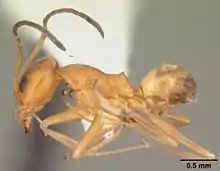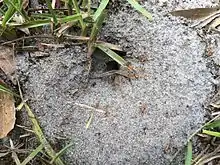| Dorymyrmex bureni | |
|---|---|
 | |
| D. bureni worker | |
| Scientific classification | |
| Domain: | Eukaryota |
| Kingdom: | Animalia |
| Phylum: | Arthropoda |
| Class: | Insecta |
| Order: | Hymenoptera |
| Family: | Formicidae |
| Subfamily: | Dolichoderinae |
| Genus: | Dorymyrmex |
| Species: | D. bureni |
| Binomial name | |
| Dorymyrmex bureni (Trager, 1988) | |

_(7436297672).jpg.webp)
Dorymyrmex bureni, also known as the pyramid ant, is a species of ant in the genus Dorymyrmex. Described by Trager in 1988, the species is endemic to the United States and Mexico.[1] Pyramid ants are medium-sized ants, ranging from 2–4 mm. They are light orange in color and fast moving. Unlike other ants in the area like red imported fire ants (Solenopsis invicta), this species is not aggressive towards humans. The workers have a foul smelling coconut odor when crushed. Dorymyrmex bureni hunt living insects, even other winged ants. They also search for sap-sucking insects from which they collect honeydew. On the head of these ants are curved hairs, used for transporting beads of damp sand. Colonies are small. Nests usually have a single entrance with a mound of sand shaped like a crater. Dorymyrmex bureni prefer sandy soil. This species of ant is not an indoor pest, and pesticides should not be used. They are found throughout Florida.[2]
References
- ↑ Trager, J. C. 1988a. A revision of Conomyrma (Hymenoptera: Formicidae) from the southeastern United States, especially Florida, with keys to the species. Fla. Entomol. 71: 11-29 (page 19, figs. 2, 9, 19, 20 worker, queen described)
- ↑ "University of Florida: Department of entomology". www.flrec.ifas.ufl.edu. Archived from the original on 2015-05-25.
External links
 Media related to Dorymyrmex bureni at Wikimedia Commons
Media related to Dorymyrmex bureni at Wikimedia Commons